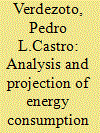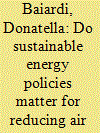|
|
|
Sort Order |
|
|
|
Items / Page
|
|
|
|
|
|
|
| Srl | Item |
| 1 |
ID:
169713


|
|
|
|
|
| Summary/Abstract |
A forecast model for the Ecuador energy sector was elaborated, by using LEAP model, this study aims to analyze the behavior of the energy matrix depending on energy forecast and efficiency policy scenarios, applying a bottom-up analysis and considering the latest politics/infrastructure planning background in Ecuador. The model and considerations proposed will result in a final energy consumption of 158 million BOE in 2030, in which the transportation sector is the main energy consumer. Regarding Ecuador energy planning, of which a critical point is the hydroelectricity available due to the commissioning of new hydro power plants, estimated at 63,513 Gwh in 2030, this value is 3.25 times that generated in 2010. In addition, the energy saving of 15 million BOE is forecast, as well as the reduction in GHG emission related to that saving due to the energy efficiency program PEC, which replaces LPG stoves with induction stoves in Ecuadorian households. Results point out that energy efficiency policies for the transportation sector would reduce oil products (2.97% in the high growth scenario), which could be reallocated to the industrial sector. Finally, another critical point is the rapid decline in the oil self-sufficiency, estimated at 15 years counted from 2030.
|
|
|
|
|
|
|
|
|
|
|
|
|
|
|
|
| 2 |
ID:
111397


|
|
|
|
|
| Publication |
2012.
|
| Summary/Abstract |
To-date, decomposition analysis has been widely used at the macro-economic level and for in-depth analyses of the industry and transport sectors; however, its application in the residential sector has been rare. This paper uses the Log-Mean Divisia Index I (LMDI-I) methodology to decompose gas consumption trends in the gas-connected residential sector in Ireland from 1990 to 2008, which despite an increasing number of energy efficiency policies, experienced total final consumption growth of 470%. The analysis decomposes this change in gas consumption into a number of effects, examining the impact over time of market factors such as a growing customer base, varying mix of dwelling types, changing share of vacant dwellings, changing size of new dwellings, the impact of building regulations policy and other factors such as the weather. The analysis finds the most significant effects are changing customer numbers and changing intensity; the analysis also quantifies the impact of building regulations and compares it with other effects such as changing size of new dwellings. By comparing the historical impact on gas consumption of policy factors and non-policy factors, this paper highlights the challenge for policy-makers in achieving overall energy consumption reduction.
|
|
|
|
|
|
|
|
|
|
|
|
|
|
|
|
| 3 |
ID:
176655


|
|
|
|
|
| Summary/Abstract |
Over the last two decades, the European Union and its Member States have introduced policies aimed at improving energy efficiency. The Energy Service Directives (ESD) introduced the concept of measurement of energy savings attributed to policies. Two different and complementary methodologies for the evaluation of energy savings have been developed under the ESD: the bottom-up (BU) approach, based on a technical analysis of each measure, and the top-down (TD) approach, based on the analysis of how energy intensity changes over time. BU methods can hardly take into account policy-induced behavioural changes, whereas TD methods have difficulties in disentangling policy-induced savings from other savings. Econometric models have been proposed as a viable alternative to deal with both drawbacks. The purpose of this article is to present an econometric model aimed at estimating the energy savings induced by energy efficiency policies in the EU Member States in the period 1990–2013. We introduce an explicit measure of Energy Policy Intensity based on the MURE database, which is used as explanatory variable in a dynamic panel model for 29 European countries. Our results suggest that energy consumption in 2013 in Europe would have been about 12% higher in the absence of energy efficiency policies.
|
|
|
|
|
|
|
|
|
|
|
|
|
|
|
|
| 4 |
ID:
176767


|
|
|
|
|
| Summary/Abstract |
Yes, they matter. To reply to this question, we assess the impact of energy efficiency and renewable energy policies on six different air pollutants: carbon dioxide (CO), methane (CH), nitrous oxides (NO), non-methane volatile organic compounds (NMVOCs), nitrogen oxides (NO) and sulfur dioxide (SO) in Italian provinces in the decade 2005–2015. The empirical analysis is performed in a panel data context by means of propensity score matching with multiple treatments, since our framework is characterized by the presence of two treatments, corresponding to the two different energy policies analyzed, i.e. energy efficiency policy and renewable policy. These two policies can be applied by each province as mutually exclusive strategies or as joint strategies. Our results show that renewable policies are the most effective in terms of climate goals especially when implemented on a local scale, while energy efficiency policies alone are ineffective. Moreover, the success of these policies depends on the type of pollutant to be reduced. Finally, we note that the effect of energy policies was reinforced by the counter-cyclical fiscal policies implemented to counter the Global Financial Crisis in 2008.
|
|
|
|
|
|
|
|
|
|
|
|
|
|
|
|
| 5 |
ID:
125518


|
|
|
|
|
| Publication |
2013.
|
| Summary/Abstract |
Energy efficiency is considered one of the most cost effective ways to enhance security of energy supply and reduce greenhouse gas emissions. According to Europe's Energy Efficiency Plan, the biggest energy savings potential in the EU lies in the built environment. However, the many barriers to energy efficiency have prevented the implementation of the existing potential so far. This paper evaluates the existing policy instruments aimed at energy efficiency in buildings in Spain as laid down in the 2nd National Energy Efficiency Action Plan (NEEAP). The results show that the current policy package is insufficient to yield the existing energy savings potential in this sector. As much of the savings potential can be found in existing buildings and realization of this potential very much relies on voluntary action, the renovation sector is in need of an appropriate financial framework that mobilizes sufficient public and private financial resources, and transparent and efficient mechanisms to ensure the return on investment and payments from those who benefit from the renovation. Such financial framework needs to be supported by a regulatory framework that is tuned to existing buildings and an organizational framework that effectively connects the different policy layers in Spain.
|
|
|
|
|
|
|
|
|
|
|
|
|
|
|
|
|
|
|
|
|